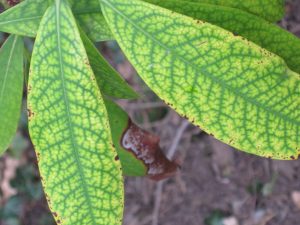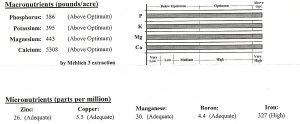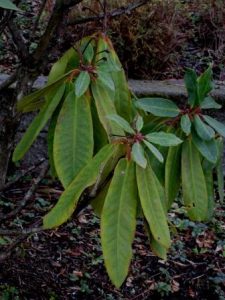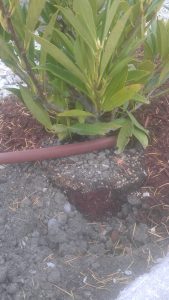As many of you know, the Garden Professors host a Facebook group dedicated to the discussion of science-based practices for gardens and landscapes. (Side note – if you haven’t joined us please do!) Recently we’ve had a spate of “what’s wrong with my plant” posts, usually focusing on some leaf issue and little other information. And far too often an eager group member will jump in with a fertilizer recommendation. So today’s blog post has two objectives: explaining why you can’t reliably diagnose problems from a picture of suffering leaves and why blanket fertilizer recommendations should be avoided.
To illustrate the problem with armchair diagnosis, consider this photo below.

Now there are two ways to ask a question here: the first is “what’s wrong with these leaves” and the second is “what’s wrong with my plant.” We can easily answer the first one: there is nutrient deficiency in the leaves, most probably iron or manganese. But that does NOT mean there is a deficiency in the soil. So we can’t address “what’s wrong with my plant” because we don’t have enough information.
How can we determine what’s wrong? My first question to the poster is invariably “have you had a soil test?” Soil test results will indicate whether the element in question is actually deficient, and will provide levels of other nutrients that could interfere with root uptake. If there’s no deficiency of the nutrient in question, then adding fertilizer is not going to help! And adding fertilizer unnecessarily can create further soil nutrient imbalances and contribute to environmental pollution.

Once we have the soil test results, we can then begin to address “what’s wrong with my plant.” But not from the original picture. (If you are curious about what else could be causing this problem, check out this blog post from 2011.)
Let’s try another. Consider the leaves in this photo:

We now know to ask “what’s wrong with these leaves?” Ignore for now the deficiencies in the older leaves and look at the size of youngest ones compared to the older. The answer is fairly straightforward here: there was too little water available when the newly emerging leaves were expanding. Leaf expansion depends on turgor pressure – the higher the turgor pressure, the larger the leaves get. Once expansion stops, protective plant biochemicals are laid down which prevent further expansion. By comparing the youngest leaves to the leaves from previous years, you can see that they are significantly smaller. But why?
Again, we need more information before we can answer “what’s wrong with my plant.” Was there too little available soil water during leaf expansion? It’s possible, but this example is from western Washington State, a climatic region with wet springs. Most likely there is an issue with the roots. My first question with these cases is “can you easily move the plant in the ground?” This is my “wiggle test” – a way to determine if roots are established. In this case – and in nearly every case like this that I’ve seen personally – the roots are NOT established. Often this is because the plant (1) was not bare-rooted at planting and/or (2) was planted too deeply. Without decent root establishment there is not enough water uptake to support full turgor in expanding leaves.

Lack of an established root system also account for the interveinal chlorosis you can see in the oldest leaves. These leaves are fully expanded, probably because the plant was still at the nursery when these leaves emerged. But their color is off. A root system that doesn’t supply sufficient water for leaf expansion is by default not going to provide sufficient nutrients, either. Adding fertilizer to this plant is not going to help! It needs to be dug up and replanted correctly or replaced. It is never going to thrive under the current conditions.
Armchair diagnosis can be accurate and fun if you follow a set of guidelines to extract more information. But simply recommending a fertilizer based on leaf appearance is neither science-based nor environmentally responsible.

Thank you for this, Linda. I find foliar lab analysis to be quite helpful as well. Often, the micronutrient is present in the soil but not chemically available to the plant. Unfortunately, many of the nutrient and micronutient tests I am familiar with fail to address soil health and ecology, factors which seem just as important to ultimate plant recovery, Then, of course, there is soil composition and buffering capacity. I don’t care what soil or foliar tests say, it will be difficult to establish rhododendron in the limestone based clay soils in my area no matter how much fertilizer you throw at it!
Thanks, Ron. I agree that soil tests for non-ag production sites have a long way to go to become relevant.
This particular rhody is from the PNW, where they grow like weeds. Our state flower is a native rhododendron. Of course you have to choose site-appropriate plants, but this was not a case of
So many of these things have a wide range of diverse causes many of which bear no or little relationship to what you might find from leaf or soil analysis of levels of nutrients. Bad drainage and/or drought is high on my own list of what can go wrong.
Hi Roger –
Thanks for the comment. Sorry, I had to remove your link – we don’t generally allow outside links.
How often should we get a soil test?
You should have one before you do any sort of significant planting. Then it depends on your issues. If you don’t have any serious deficiencies or toxicities, I wouldn’t worry about doing it very often as long as you aren’t putting significant nutrient inputs in (that includes any sort of rich organic material). If you do have some serious problems, I’d test once a year at the same time each year to monitor the problem as you treat it.